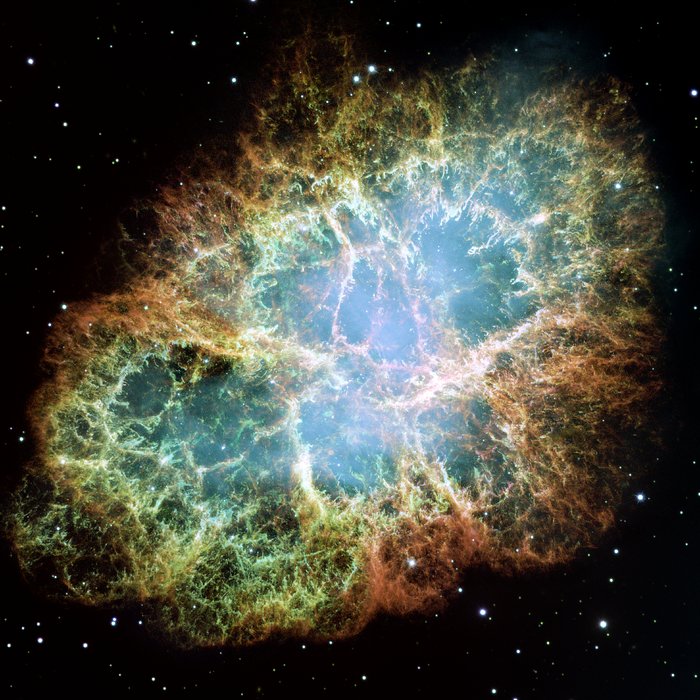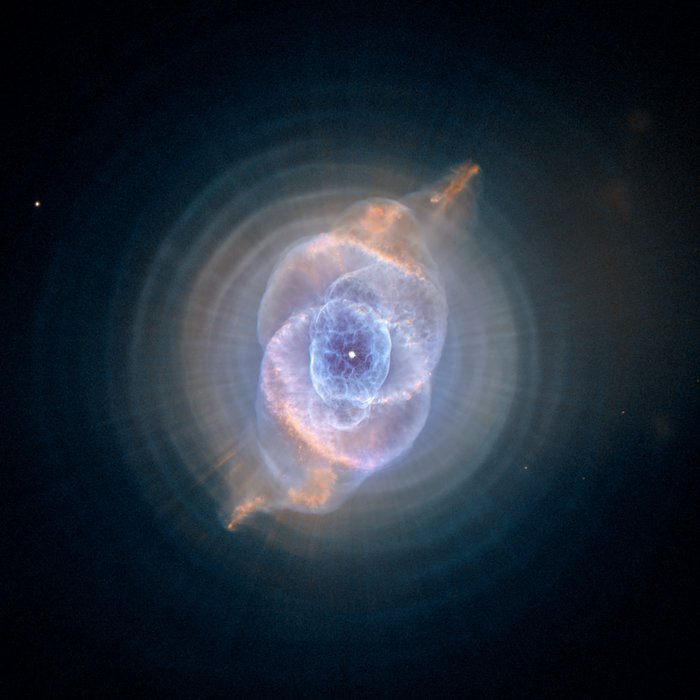Stardust and Eternity – 3.4.5
The Death of a Star
Stars positioned on the Main Sequence – the band running from the upper left to the bottom right of the Hertzsprung–Russell (H-R) diagram, that links stars’ temperatures to their luminosities – spend about 90% of their lives fusing hydrogen into helium and producing enough fusion pressure to sustain them against deadly gravitational collapse. For common G-type stars like the Sun, their stable life on the Main Sequence lasts about 10 billion years (we are halfway through right now). However, once the supply of hydrogen in their cores is exhausted, the subtle equilibrium between gravity and outward pressure starts to deteriorate. At this stage, the star’s structure begins to falter, sometimes abruptly: gravity takes over and begins compressing the star, thus rising its temperature and igniting a shell of hydrogen surrounding the inert helium core. Eventually, the star expands up to 100- 1000 times wider, turning into a cooler star shining in the redder part of the electromagnetic spectrum – thus becoming a “red giant”. It is half as hot as the Sun, and moves to the upper right-hand side of the H-R diagram. The red giant phase may last up to a few hundred million years. Meanwhile, as the helium core continues to contract, helium ignites and is rapidly fused into carbon. When the helium is also exhausted, the melting stops, the core shrinks again and a helium shell surrounding the newly formed inert carbon core begins to ignite, leading to further expansion of the star and the ejection of its outer layers into a spherical cloud of matter – misleadingly (for historical reasons) called a “planetary nebula”. What remains, at the center of the nebula, is the hot very compact carbon core, or “white dwarf”, similar to Earth in size and supported against further collapse by a quantum effect called “electron degeneracy pressure”, due to the tightly packed electrons.
This scenario applies to relatively low-mass stars like the Sun. As for more massive stars (between approximately 5 and 10 solar masses), their core continues to progressively fuse into heavier elements besides carbon – thus leading to an onion-like internal structure, which contains an inert iron core. However, unlike all previous stages of nuclear fusion that generated energy, the fusion of iron into heavier elements does not lead to a release of energy, but to the opposite effect, i. e. absorption. The core collapses under its own gravity until the protons of the iron nuclei combine together with the electrons, creating an extremely compact “neutron star”. A neutron star size is about 10 km and contains 1.4 solar masses, supported against further collapse by the so-called “neutron degeneracy pressure” – due to the tightly packed neutrons. While reaching its minimum size, the neutron core begins to rebound, causing a shock wave to move through the outer layers into the infalling stellar material and to explode the outer layers, thus generating a “supernova”. This explosion lefts behind a residue which stays visible for hundreds of years. The Crab nebula (M1) – in the constellation of Taurus – is a remarkable example of a supernova remnant. It exploded in 1054 and was recorded by Chinese astronomers of the time. The supernova was visible for months in the sky as a “guest star” even in daylight.
For stars whose cores are more massive than about 3 solar masses, the neutron degeneracy pressure is NOT able to support their gravitational collapse. The star thus collapses until it becomes a black hole – an object so compact that even light cannot escape it. We cannot actually “see” a black hole, but only what lies beyond the sphere surrounding it, the so-called “event horizon”. The presence of the black hole can be inferred by means of the hot accretion disk that forms around it. The first “direct image” of a black hole was released in 2019, following observations by the Event Horizon Telescope (EHT) of the supermassive black hole in the galaxy M87. In 2022, astronomers were also able to release the first image of the accretion disc around the horizon of Sagittarius A* – a black hole of about 4 million solar masses at the center of our galaxy.
Further Resources
Links below will redirect you to external websites. In accordance with the European data protection declarations, we would like to point out that by clicking on these links you may send data to external providers. We cannot prevent that.
Images
![]() Most detailed image of the Crab Nebula (NASA, ESA and A. Loll/J. Hester)
Most detailed image of the Crab Nebula (NASA, ESA and A. Loll/J. Hester)
![]() The Veil Nebula: Supernova remnant (NASA, ESA, Hubble Heritage Team)
The Veil Nebula: Supernova remnant (NASA, ESA, Hubble Heritage Team)
![]() Cassiopeia A: the youngest known supernova explosion in the Milky Way (NASA, ESA, and the Hubble Heritage (STScI/AURA), R. A. Fesen, and J. Long)
Cassiopeia A: the youngest known supernova explosion in the Milky Way (NASA, ESA, and the Hubble Heritage (STScI/AURA), R. A. Fesen, and J. Long)
![]() Planetary nebulae M57: the Ring Nebula Hubble Heritage Team (AURA/STScI/NASA/ESA)
Planetary nebulae M57: the Ring Nebula Hubble Heritage Team (AURA/STScI/NASA/ESA)
![]() Planetary Nebulae: NGC 6302 and NGC 7027 (NASA, ESA, and J. Kastner, RIT)
Planetary Nebulae: NGC 6302 and NGC 7027 (NASA, ESA, and J. Kastner, RIT)
![]() The Twin Jet Nebula (ESA/Hubble & NASA, and J. Schmidt)
The Twin Jet Nebula (ESA/Hubble & NASA, and J. Schmidt)
![]() Cat’s Eye Nebula (ESA, NASA, HEIC and The Hubble Heritage Team, STScI/AURA)
Cat’s Eye Nebula (ESA, NASA, HEIC and The Hubble Heritage Team, STScI/AURA)
![]() Supernova 1994D in the galaxy NGC 4526 (NASA/ESA, The Hubble Key Project Team and The High-Z Supernova Search Team)
Supernova 1994D in the galaxy NGC 4526 (NASA/ESA, The Hubble Key Project Team and The High-Z Supernova Search Team)
![]() Exploding dwarf (NASA/ESA/A. Feild (STScI)
Exploding dwarf (NASA/ESA/A. Feild (STScI)
![]() SN 2006X, before and after the Type Ia Supernova explosion (ESO)
SN 2006X, before and after the Type Ia Supernova explosion (ESO)
![]() Neutron star over Munich (ESO / ESRI World Imagery, L. Calçada)
Neutron star over Munich (ESO / ESRI World Imagery, L. Calçada)
![]() Anatomy of a Black Hole (ESO)
Anatomy of a Black Hole (ESO)
Videos
![]() White Dwarfs & Planetary Nebulae: Crash Course Astronomy
White Dwarfs & Planetary Nebulae: Crash Course Astronomy
![]() Neutron Stars: Crash Course Astronomy
Neutron Stars: Crash Course Astronomy
![]() The Life Cycle Of Stars: How Stars are Formed and Destroyed
The Life Cycle Of Stars: How Stars are Formed and Destroyed
![]() Black Holes: Crash Course Astronomy
Black Holes: Crash Course Astronomy
![]() Less Than Five – What is a Supernova?
Less Than Five – What is a Supernova?
![]() Black Holes 101 | National Geographic
Black Holes 101 | National Geographic
 Le Nane Bianche (Antonio Loiacono)
Le Nane Bianche (Antonio Loiacono)
 Morte di una stella in 3D (AsiTV)
Morte di una stella in 3D (AsiTV)
 Stephen Hawking – I Buchi Neri
Stephen Hawking – I Buchi Neri
Online Resources
![]() The Final Stages of the Evolution of a Sun-like Star
The Final Stages of the Evolution of a Sun-like Star
![]() Planetary Nebulae and White Dwarfs
Planetary Nebulae and White Dwarfs
![]() The Evolution of Massive Stars and Type II Supernovae
The Evolution of Massive Stars and Type II Supernovae
 Nane Bianche (INAF – Osservatorio Astronomico di Capodimonte)
Nane Bianche (INAF – Osservatorio Astronomico di Capodimonte)
 Le nane bianche e l’aspettativa di vita dell’Universo (Focus)
Le nane bianche e l’aspettativa di vita dell’Universo (Focus)
 Quando il Sole morirà diventerà una nana bianca: le caratteristiche di questo “cadavere stellare” (Geopop)
Quando il Sole morirà diventerà una nana bianca: le caratteristiche di questo “cadavere stellare” (Geopop)
 Supernovae (INFN – Istituto Nazionale di Fisica Nucleare)
Supernovae (INFN – Istituto Nazionale di Fisica Nucleare)
 Cosa sono i buchi neri, come nascono e quali tipologie esistono (Geopop)
Cosa sono i buchi neri, come nascono e quali tipologie esistono (Geopop)
Further Readings
![]() Supernovae And How to Observe Them (Martin Mobberley)
Supernovae And How to Observe Them (Martin Mobberley)
![]() Cataclysmic Cosmic Events and How to Observe Them (Martin Mobberley)
Cataclysmic Cosmic Events and How to Observe Them (Martin Mobberley)
![]() Extreme Explosions (David S. Stevenson)
Extreme Explosions (David S. Stevenson)
![]() Stardust, Supernovae and the Molecules of Life (Richard N. Boyd)
Stardust, Supernovae and the Molecules of Life (Richard N. Boyd)
![]() Planetary Nebulae and How to Observe Them (Martin Griffiths)
Planetary Nebulae and How to Observe Them (Martin Griffiths)
 BUCHI NERI: DA CURIOSITA’ MATEMATICA ALLA PRIMA EVIDENZA DIRETTA (Liwei Hu)
BUCHI NERI: DA CURIOSITA’ MATEMATICA ALLA PRIMA EVIDENZA DIRETTA (Liwei Hu)
 CONDIZIONI DI EQUILIBRIO DI UNA NANA BIANCA (Bruno Martinico)
CONDIZIONI DI EQUILIBRIO DI UNA NANA BIANCA (Bruno Martinico)
Teaching Material
For Kids
 Le supernove (ESA – Space for Kids)
Le supernove (ESA – Space for Kids)
 La morte delle stelle (ESA – Space for Kids)
La morte delle stelle (ESA – Space for Kids)
 I Buchi Neri – BREVE CARTONE ANIMATO
I Buchi Neri – BREVE CARTONE ANIMATO
 In Viaggio nello Spazio con Margherita Hack – I Buchi Neri (video)
In Viaggio nello Spazio con Margherita Hack – I Buchi Neri (video)


